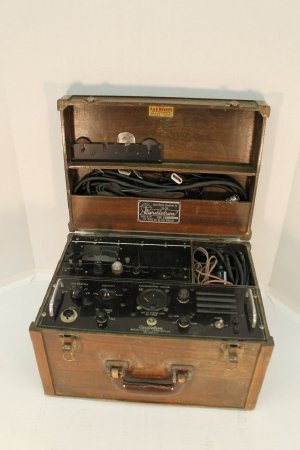Object ID Number:
EH101136
Object Name:
Electrocardiograph Machine
Type:
EKG Machine; Cardiotron
Manufacturer:
Electro–Physical Laboratories Inc. – New York, NY
Date of Manufacture:
/ /
Manufactured from:
1944
Manufactured to:
1960
Description / History:
The Cardiotron was the first direct–writing electrocardiograph, developed by Paul Traugott, President and Chief Engineer of Electro–Physical Laboratories, Inc., a division of Electronic Corporation of America. This model was sold by L&B Reiner, Eastern Representatives out of New York as well. The machine is in a wooden box with a leather–covered handle. The inside face of the model along with many of the dials are black plastic. This ECG machine recorded the activity of the heart on paper. It is a PC–1A model and has a serial number of A–3076, dating it the 1940s. It was made after 1944, because this is the year that Traugott first applied for his patent of his ECG machine.
Dimensions:
H–11.5 W–9.5 L–16 inches
Additional Information:
Electrocardiograms (EKGs)
An electrocardiogram (also called ECG or EKG) is a noninvasive test that records the electrical activity of the heart. This examination is useful because, with each heartbeat, an electrical signal spreads from the top to the bottom of the heart. As this electrical signal travels, it induces the heart to contract, and to pump blood throughout the body. Since the heart's electrical signals determine the rhythm of the heartbeat, an EKG can be used to show how quickly the heart is beating, whether the heart's rhythm is steady or irregular, and how strongly the electrical signals pass through each part of the heart. Based on these readings, a physician may discover a number of conditions, such as arrhythmias or recent heart attacks, and may also monitor the functioning of implanted pacemakers.
The earliest electrocardiogram was designed in 1901 by William Einthoven, a scientist from the Netherlands. In Einthoven's design, currents from the heart's electrical signals were carried down a silver coated glass conducting wire which was suspended between two electromagnets. The fluctuations of the wire as a result of the changing electrical currents were transcribed onto a photographic plate and produced readouts similar to those given by modern EKGs (although Einthoven's machine weighed 600 pounds, took up two rooms, and needed five people to operate).
EKGs remain one of the most important diagnostic tools today, and in 2011, 82,707 EKGs were performed at Lancaster General Hospital (or affiliated healthcare institutions), which amounts to a staggering 226 per day.
An electrocardiogram (also called ECG or EKG) is a noninvasive test that records the electrical activity of the heart. This examination is useful because, with each heartbeat, an electrical signal spreads from the top to the bottom of the heart. As this electrical signal travels, it induces the heart to contract, and to pump blood throughout the body. Since the heart's electrical signals determine the rhythm of the heartbeat, an EKG can be used to show how quickly the heart is beating, whether the heart's rhythm is steady or irregular, and how strongly the electrical signals pass through each part of the heart. Based on these readings, a physician may discover a number of conditions, such as arrhythmias or recent heart attacks, and may also monitor the functioning of implanted pacemakers.
The earliest electrocardiogram was designed in 1901 by William Einthoven, a scientist from the Netherlands. In Einthoven's design, currents from the heart's electrical signals were carried down a silver coated glass conducting wire which was suspended between two electromagnets. The fluctuations of the wire as a result of the changing electrical currents were transcribed onto a photographic plate and produced readouts similar to those given by modern EKGs (although Einthoven's machine weighed 600 pounds, took up two rooms, and needed five people to operate).
EKGs remain one of the most important diagnostic tools today, and in 2011, 82,707 EKGs were performed at Lancaster General Hospital (or affiliated healthcare institutions), which amounts to a staggering 226 per day.
